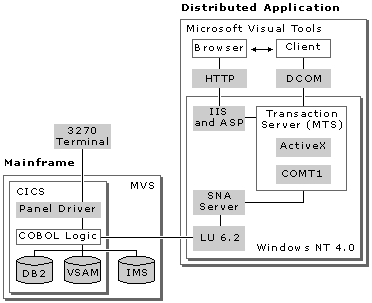
If your enterprise application requires integration of the distributed computing environment with the mainframe computing environment, then the SNA Server Component Object Model Transaction Integrator (COMTI) is the most suitable tool for you to use. With COMTI you can build Windows–based distributed applications that integrate with the IBM Customer Information Control System (CICS) and IBM Information Management Systems (IMS) programs running on IBM's Multiple Virtual Storage (MVS) operating system.
Because COMTI can access CICS programs as well as the data available to the CICS regions, you can also use it to extend the client application — through CICS — to any other program on the MVS mainframe. Since COMTI does all of its processing on the Windows NT Server, there is no COMTI-specific executable code that you have to run on the mainframe, and you won't have to rewrite most mainframe COBOL programs.
Working in conjunction with the Microsoft Transaction Server (MTS) and the Microsoft SNA Server, COMTI makes CICS and IMS programs appear as typical MTS components that can be packaged with other components when building distributed applications. COMTI supports all distributed applications adhering to distributed COM (DCOM) and Automation specifications. Additionally, because COMTI supports recordsets, your application can use the familiar ActiveX® Data Objects (ADO) interface to handle the mainframe data access requirements.
For More Information For more information on using ADO to access all of your enterprise data, see Data Access Using ActiveX Data Objects (ADO) in this chapter.
As a generic proxy for a mainframe, COMTI intercepts object method calls and redirects those calls to the appropriate mainframe program. COMTI also handles the return of all output parameters and return values from the mainframe. When COMTI intercepts the method call, it converts and formats the method's parameters from the representation understood by Windows NT into the representation required by the mainframe programs. The following drawing shows how these features interact.

You can also use COMTI to access a DB2 database via a CICS proxy. Although this may require some CICS programming, and will definitely require writing an MTS application, it is the best architecture for applications that need to write DB2 data — especially if the same DB2 region may be used by other CICS applications.
Although you can use COMTI in simple mainframe data access applications, it becomes an even more powerful tool when used to extend transactions from the Windows NT Server environment to the mainframe. Using COMTI and MTS, you can make mainframe programs available to COM-supported clients and their Web-based applications. In addition, MTS component designers can include mainframe applications within the scope of two-phase commit transactions.
The COMTI component of SNA Server represents an important extension of your Windows-based application into the data, transactions, and applications that run on the mainframe. The following topics will acquaint you with what COMTI is and how it works.
| Section | Description |
| COMTI Is a Proxy for the Mainframe | Explains how COMTI works as a generic proxy for the mainframe, intercepting object method calls and redirecting them to appropriate mainframe programs. |
| Extending Transactions to the Mainframe with COMTI | Describes how transactions can be extended from the Windows NT Server environment to the mainframe. |
| COMTI Programming Model | Describes the three mainframe programming models that COMTI supports. |
| COMTI Support for Mainframe Transaction Processing | Describes the three classes of mainframe Transaction Programs that COMTI supports. |
For More Information For more information on how SNA Server supports distributed application integration with mainframe data and processes, see the Web site at http://www.microsoft.com/sna.